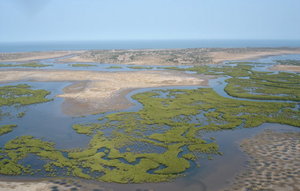Advertisement
Published: December 4th 2008

 Palmarin from the sky
Palmarin from the sky
Ariel photo of the mangrove trails streching out to the coast.Since I’ve last written many things have changed. The eight weeks language classes, cultural adaption lectures, security briefings and of time with my home-stay family in Thiafaitche have all come to an end. As I write I’ve been in the village of Diakhanor, my site for the next two years, for a little over a week. Diakhanor is one of the four villages that make up the Palmarin region, a 17km long peninsula caught between the Atlantic and Sine-Soloum Delta. To my west approximately 300yds are the last stretches of the Petit Cote beaches, a unique place where palms and boa bobs intermingle in the ocean breezes. The tourist season has yet to come full swing and now the beaches lack much in the form of human population short of a frequent progression of pirogues coming and going with the days catch. To my east are the tangling mangrove trails of the Sine-Saloum delta, a combination of unspoiled shallow channels and mangrove forests on the outskirts of the 800,000 hectare reserve. A little further north the peninsula widens and is dotted with raised islands amongst sand flats and lower flooded areas. The Delta is not fed by a fresh water source

 At Work
At Work
Fisherman bringing in the days catch. Pirogues are used to cast a large net which is pulled hand over hand to the beach. but is rather an intrusion of the Atlantic cutting deep into the country. For this reason you can find in the area salt water collection pools that, once evaporated off are a local source of salt production. The drier areas also home to a small population of hyenas whose calls can be heard in the quite nights. I am not sure which other large game animals exist in the reserve to sustain the hyenas but I’ve seen first hand they will venture close to the villages in search of domestic animals such as donkeys. Other large animals here include monitor lizards, which some Senegalese eat, mongoose, monkeys and a plethora of fowl for which the region is known. The marine life is a combination of ocean life to the west on which the fishermen of the pirogues make there living and to the east in the delta an abundance of cruastations such as clams, snails and mollusks which are collected by wading out into the flats. The beaches are also important nesting sites for various marine turtles.
My initial response is this place should support a nice quality of life. There is a mix of rural Africa and upscale tourism

 End of the day
End of the day
Late in the afternoon the last Pirouges are dragged onto the beach for the night. The catch has already been dropped off at the port on the intercoastal to break any monotony and provide a dynamic blend of people as work partners and sources of conversation. I’m looking forward to the experience. All is well here. I hope the same is so back home.
Advertisement
Tot: 0.121s; Tpl: 0.012s; cc: 10; qc: 62; dbt: 0.0485s; 1; m:domysql w:travelblog (10.17.0.13); sld: 1;
; mem: 1.2mb

 Palmarin from the sky
Palmarin from the sky
 At Work
At Work
 End of the day
End of the day
